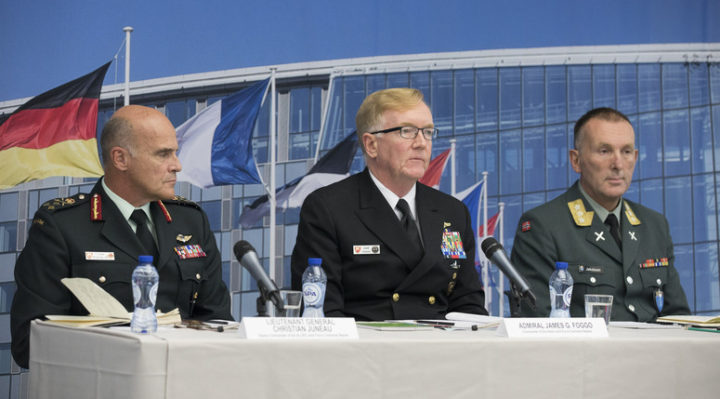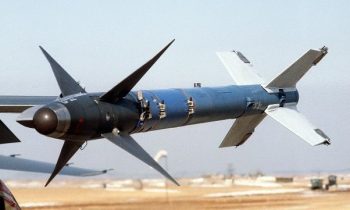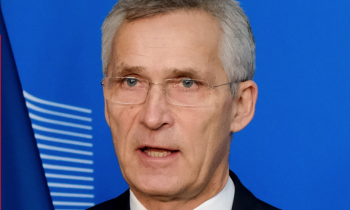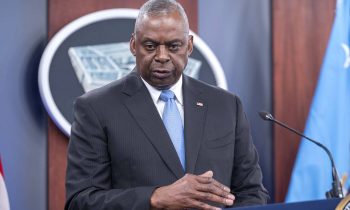with Admiral James G. Foggo, Commander of Allied Joint Force Command in Naples, Italy, and Lieutenant General Rune Jakobsen, Commander of the Norwegian Joint Headquarters in Bodø, Norway

Piers Cazalet: Good afternoon ladies and gentlemen, apologies for the delay this morning. We have just come out of a long North Atlantic Council meeting where the Admiral was briefing ambassadors on Trident Juncture. So if Admiral Foggo could first of all say a few words, and then we will pass to General Jakobsen. Admiral.
Admiral Foggo: Thank you Piers, for bringing us here together today. Ladies and gentlemen, again apologies for running late, we didn’t expect the meeting to go that long. I thought we would be here thirty minutes ago. I did a similar event here last year that some of you may have attended, and I am pleased to be back at this marvellous NATO headquarters today with Lieutenant General Jakobsen and Lieutenant General Christian Juneau. Christian is my honourable deputy, in Naples, he is a Canadian Forces Officer, as you can see, and he will be operating with the Land Component on the ground for Exercise Trident Juncture alongside General Jakobsen while I am at sea doing what I do best.
The Trident Juncture exercise will take place in and around Norway from October 25th to November 7th. We have been very open about these dates, and they have been consistent. We will have advance activities taking place in and around Iceland from October 15th to the 17th. General Juneau will oversee the exercise from the NATO Joint Warfare Centre in Stavanger and I will travel throughout the region, be there for the amphibious landings and get ashore and do key leader engagement and observe the exercise as it takes place. I will also be on the beach for the conduct of the DV Day [Distinguished Visitors’ Day] on the 30th October.
We are boiling down Trident Juncture to a core theme of just a few words, I call it the three Ds – NATO is a Defensive alliance, Trident Juncture Demonstrates our credible capability, and together we Deter potential adversaries. All 29-member NATO nations will participate in the exercise, along with our partners from Sweden and Finland. And we are delighted about that.
Trident Juncture illustrates NATO’s relevance and unity, and that we are ready to defend ourselves and the territory which is contained within those 29 allied nations. At the core of the exercise is the NATO Response Force and within that, the 5000 person-plus Spearhead force, otherwise known as the VJTF or the Very High Readiness Joint Taskforce.
Today it is my privilege to announce that the aircraft carrier USS Harry S. Truman and its strike group, including its ships and aircraft, will participate in Trident Juncture, adding about 6000 personnel to the mix. That puts our total strength up at 45 plus 5 – you can do the math. The US Navy is demonstrating its capability because of our flexibility, our agility and our commitment to the Alliance. And we have deployed the Harry S. Truman as a function of our dynamic force employment planning throughout the globe. And it’s one of the first platforms to actually participate in dynamic force employment; it came to the theatre, went back to the States and then returned just a month ago. While Truman remains ready rapidly to respond to any crisis anywhere, I am thrilled to announce my intent to employ this very capable strike group in Trident Juncture commencing on the 25thOctober.
I am confident Trident Juncture will be an outstanding opportunity to demonstrate our unity and resolve, and I am very grateful to our very capable NATO Ally and host nation Norway. General Jakobsen commands Norway’s joint force headquarters in Bodo, I had the pleasure of visiting him the headquarters this year, and I am thrilled with their incorporation of NATO into Norway’s Total defence concept. Their planning and support has been nothing short of stellar. Over to you for your prospective.
Lt Gen Jakobsen: Thank you very much Admiral for your kind words and I take the opportunity to highlight the outstanding partnership we have enjoyed with Joint Force Command Naples in all aspects of the preparation for the exercise.
Our political leaders were very pleased five years ago when NATO decided to execute Trident Juncture 18 in Norway. Additionally to the benefits of stress-testing our national defence plans, we provide NATO Allies with first-hand experience of NATO’s Northern flank and hopefully, in challenging weather conditions. Norway is a small country and our defence relies heavily on NATO’s collective defence. Invoking Article 5 means to be able to receive Allied forces and reinforcements, and to that we must have plans and we mush rehearse the plans. That is why Trident Juncture 18 is important for us.
The exercise will give us the opportunity to test, evaluate, further develop our Total Defence Concept, as well as national reception plans. During the exercise, the regional forces will cooperate closely with civil emergency services, the police, the railway, port and transportation authorities, as well as with local and national businesses. The size and complexity of the exercise ensure a very realistic stress test for everybody. More than 10 thousand Norwegian troops will participate directly or indirectly, and both on the tactical and operational level; the field exercise will facilitate for testing of the interoperability and training cooperation between Allies, in a high-intensity war fighting scenario. I believe Norway will provide a unique training opportunity for all participants: with large sea, air and land areas available for manoeuvre, with very high freedom of manoeuvre in all dimensions.
Allied training in Norway is also highly appreciated by the normal population. More than 76% of our population are positive to NATO, and hopefully all allied soldiers will enjoy the hospitality of the local people in the exercise area.
I would also like to highlight the excellent partnership we have with our neighbouring countries Sweden and Finland, who will host aircraft deployments and make their airspace available for operations.
My most important task as the Joint Force Commander is to provide a good training experience for all participating troops and nations. And facilitate for every unit to meet their training objectives through the best possible host nation support. The only important task for me is to support the Commander to create a safe exercise environment. Thanks for your attention I will give the word to Piers to lead.
Piers Cazalet: Thank you very much, now we have some time for questions. If you have a question could you, please say your name and your outlet. Yes, please?
Bulgarian Club Z media: How far from the Russian border will it take place, that’s the first question; and second question, so, according to the scenario, NATO will repel attack from the North. Does it mean that this imaginary attack will come from Russia? Thank you.
Adm. Foggo: How far from the Russian border, well, Norway has a border with Russia, and we are operating in Norway and we are operating North as far as Tromso and Alta. I will let Commander Jakobsen comment on that or add to that if he desires. This exercise has several messages, that is, NATO is capable of defending, it is capable of deterring any adversary, not anyone in particular, no particular adversary, in the conduct of its operations throughout the theatre of the Alliance. And that is what we intend to do, so I wouldn’t comment on any particular country. This is a message to anyone who might conduct any kind of aggressive act leading to an Article 5 scenario inside the NATO Alliance. Did you want to comment?
Lt. Gen. Jakobsen: Yeah, the core exercise area is more than one thousand kilometres from the Russian border, and air operations could take place up to five hundred kilometres away from the border, so there should not be any reason for the Russians to get scared, or see this as something else than a defensive exercise. And the six brigades training, they train both offensive and defensive operations, so the scenario is designed to make the units on the battalion and brigade level meet their training outcomes.
ARD: I was just wondering, Admiral, can you say anything about the role of the German contribution of the exercise and second, I would like to have some personal views of your dedication to the transatlantic security environment and your personal dedication to NATO?
Admiral Foggo: I was born in Mönchengladbach in NATO in Northern Army headquarters of Rheindahlen in 1959, so you might say I was born into NATO. This is my fifth assignment in Europe, my forth command in NATO if you include the JTF that I commanded during the Unified Protector transition. I am a firm transatlanticist; I have been educated in Europe, at Strasburg – the heart of the European community, and that’s the reason I think I’m here in this job. It is a dream job for me and every day I wake up and pinch myself knowing that I’m a NATO commander in Naples and I am able to get underway and go to sea with a force of over 45 thousand soldiers, sailors, airmen and marines, to defend the interest of this Alliance that I believe so strongly in.
As to the German contribution, I am pleased to say that when I was in Berlin earlier last month I had a chance to visit General Zorn, the German CHOD, and complement and congratulate him on the contribution of 85 hundred personnel and their associated kit, if you will, the equipment that they are bringing into Norway. Germany is part of the German-Netherlands Corps, which is part and parcel of the 5 thousand-plus Spearhead Force that I told you about, the very high readiness joint task force, which shows that NATO can move quickly. Part of the discussion during the Summit in July was the proposition to be able to do the 30 / 30 / 30 point, so that was to move 30 battalions, 30 aircraft squadrons or 30 ships in 30 days. The alliance aspires to be able to do that extremely well, and we will demonstrate that with the heavy logistics capability that will be demonstrated in this exercise. I think I have said it before: logistics is the sixth domain of warfare. And you can see that play out through Trident Juncture. Thank you for your question.
Lt. Gen. Jakobsen: If I can add to that – the Admiral mentioned the contribution of Germany; from the land perspective they are going to provide a brigade – a very robust brigade that will be part of the primary training audience, because the live portion of Trident Juncture 18 is focused at the brigade level. So, they have an extremely important role from the land perspective to play.
Piers Cazalet: Can we have a question over here?
Wall Street Journal – Can you talk a little bit more about the challenge of getting all the equipment into Norway because logistics and military mobility is a very big issue in Europe – the European Union is working with NATO on this – how does this play into all of that? Thank you.
Adm. Foggo: When you are talking about moving over 45 thousand soldiers, sailors and marines, over 60 ships – large ships, 120 aircraft and 10 thousand vehicles to respond to a crisis, that is no small feat. It has to be done through sealift, airlift or by land. The United Kingdom has chosen to drive its force on the land, so they’re testing their ability to do that through landlines. We have plenty of forces, lots of US forces, lots of US Marines coming from the United States, that will be exercising our ability to operate in sea lines of communication. So, part of the victory of all this is that everybody shows up on Day One on the 25th October with their associated support and ready to defend. And so, that’s when I say, logistics is the sixth domain of warfare – we are testing that. It’s not going to be perfect, we have about 10% of the personnel and the equipment on the ground right now. So we’ve got a heavy lift over the next 18 days to get the rest of those folks there and ready to defend; and it was designed that way, because that’s kind of the way we would approach a crisis – if something happens, we have got to respond.
NATO is working this through its logistics programme for delivery of equipment with all various means of delivery from the sea, from the air and from the land. And there will be some significant lessons learned out of this; and we don’t expect it to go perfectly. That’s why we do exercises. So, thanks for your question. Christian?
Lt Gen Juneau: When we talk about over 10 thousand vehicles on Norway’s roads, that will present a traffic control challenge that will stress-test the system. The second point I want to make is the weather in Norway, in late October-early November, will be a factor, for sure. As a Canadian I know what it can look like in a northern country during that time of the year. They have already had some snow in Norway, so that will certainly be stressing the movement control in our logistics, as well.
Jane’s Defence: I just wanted to build on the question about military mobility – two quick questions, how much of the NRF is going to be deployed, and I assume it’s the entire Spearhead that will be deployed? If not, could you tell us what percentages of both of those are at play? And is the way that the NRF going to be deployed in Norway designed to specifically to test military mobility, or are you relying on air transports in the past for the Spearhead? Thank you.
Christian: The whole of NRF will be deployed, it’s a brigade part of the German Netherland brigade, it will deploy from Europe it will finish an exercise, get on ships and aircraft and fly in theatre like it would happen during a conflict.
Jane’s Defence: No overland movement?
Christian: No, not from that element –
Jane’s Defence: Is that how it will always be in a war case situation?
Christian: Well, it depends on where you are going, right? So, Norway there are very few countries from where you can drive to Norway. I know the United Kingdom will deploy a significant element over land, so they’re going to drive all the way to Denmark and then they’re going to sail to Norway, just to test that military mobility that you’re talking about.
Jane’s Defence: I guess, I’m just wondering if you shouldn’t be testing more overland, testing more of the movement of the NRF overland in case in future Trident Juncture was held strictly in Eastern Europe with no sea access.
Lt Gen Juneau: Well, there are other exercises that are testing that, actually. The Noble Jump exercise that was conducted last summer in 2017, we had troops moving from Greece all the way to Romania overland.
DPA: I have a question in the same direction, a lot of experts are wondering if NATO is really capable to deploy troops very quickly – wouldn’t it makes sense to also do so called snap exercises like Russia – what do you think about it?
Admiral Foggo: I would like to get some training value out of an exercise; and whereas a snap ex will tell you something about your readiness and your ability to respond on very short notice, I think that through a deliberate plan and over the course of time, when you have an opportunity to look at different scenarios throughout the European theatre and then apply the full force and capability of NATO, is probably better training and better lessons-learned to come out of it. Particularly with regard to monitors and assessors. So, there is a lot that comes to bear to do an exercise of the volume of which Trident Juncture has become. And so I think that deliberate approach is going to allow us to take lessons learned away from this, to refine and improve our training tactics of procedures in the future, more so, than a snap ex would do. Would you like to comment on that?
Lt Gen Juneau: I can partly answer your question or concern – the VJTF – very High Readiness Taskforce, as part of their annual training plan, there is an alert exercise that is taking place. So we do that, we bring the folks in, bring the vehicles in, we don’t necessarily deploy them right away, but at least part of that readiness is tested that way.
Europa Press: Could you talk a little bit more if there is going to be any kind of training or putting into test any kind of cyber capabilities and also maybe against A2AD into the exercise? Thank you.
Admiral Foggo: I wouldn’t talk about offensive cyber capabilities, I wouldn’t talk about specific operational aspects the exercise but, I would tell you that we intend to defend our networks against anyone who might have any kind of ulterior motives while we are in the exercise; and I believe they are very robust so we will get a chance to test that.
Piers Cazalet: Any other questions? Okay. Thank you very much Admiral, Generals – thank you for your time. Thank you, ladies and gentlemen.
(NATO)



